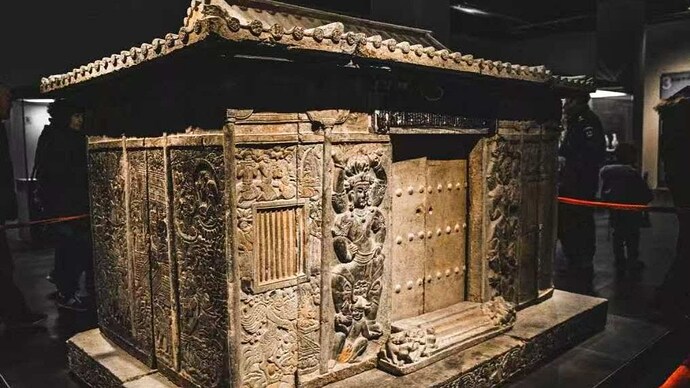6th century Brahmin who took Buddhism to China—his DNA analysis rewrites Silk Road history
Researchers at Fudan University carefully extracted DNA from Li Dan’s tooth. It highlights the long-standing cultural connections between India and China.
New Delhi: In 2005, archeologists working in Nankang village of China’s Xi’an city found a joint tomb from the 6th century, sealed for about 1,441 years. Inside, lay a couple whose burial had Chinese motifs mixed with Indian and even Roman influences.
The man was Li Dan (505-564 CE), a connection between South Asia and East Asia. His life and lineage, revealed through both stone and DNA, would rewrite a snippet of Silk Road history.
Buried near the ancient capital of Chang’an, he was not only a Chinese aristocrat but was also of Indian descent— a Brahmin.
Xu Feihong, China’s Ambassador to India, on Friday shared this discovery that seems straight out of a historical novel. The tweet noted: “Genetic analysis has shown that Li Dan, who promoted Buddhism in northern China 1,400 years ago, was an ancient Indian descendant. His tomb in northern China combines Chinese and Indian elements, making it a remarkable testament to cultural exchange along the Silk Road.”
The discovery of Li Dan’s ancestry highlights the long-standing cultural connections between India and China. However, historically, these two major Asian powers have developed deep mistrust despite their shared heritage.
Anirudh Kanisetti, an Indian historian, reflected on the broader implications of such findings. “Discoveries like this, and our shared history more broadly, should prompt greater introspection on the Chinese side about what a true partnership could look like. It is unfortunate that the two heartlands of Asian civilisation remain stuck on rigid border disputes instead of focusing on centuries-long opportunities for collaboration, exchange, and cultural connection,” he told ThePrint.
A paradox
Li Dan’s epitaph told two stories that contradicted each other. On one side, he claimed descent from South Asia, describing his forefathers as “Brahmins from Jibin (an ancient South Asian kingdom encompassing present-day Kashmir and surrounding regions) or Tianzhu (an ancient Chinese term for India).”
And in the same inscription, he posited a northern Chinese origin, and associated himself with the Pingji Li Branch, a lineage from Hebei province known among the Northern and Southern Dynasties’ aristocracy.
His tomb also reflected the same paradox. “Themes on the stone cist coffin reflected a fusion of Chinese traditions and foreign influences,” a study described. Taoist figures like the Four Divine Beasts, Fu Xi, Nu Wa, and Xingxiu were carved alongside foreign motifs, including guardian figures resembling Buddhist statues from Tianzhu, such as the Vajra Guardians and Heavenly Kings.
For centuries, his true origin remained a question. But at Fudan University, researchers found the answer.
They carefully extracted DNA from his tooth and his consort’s temporal bone. Despite the age and low DNA levels, they were able to get detailed genome-wide data.
The results confirmed that Li Dan was male and revealed that he carried “distinct northern South Asian and northern China-related ancestries”, explaining the tomb’s culture mix.
Li Dan’s genome offered something extraordinary.
“For Li Dan, genetic analysis reveals a close relationship with modern Brahmins, supporting his Brahmin status and his biography as the progeny of Brahmanic descent,” the study noted.
Source: 6th century Brahmin who took Buddhism to China—his DNA analysis rewrites Silk Road history
